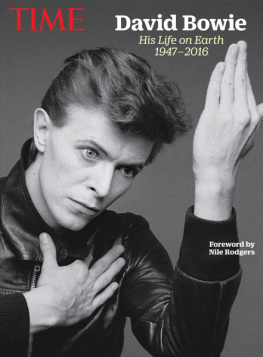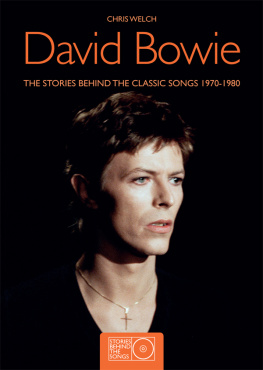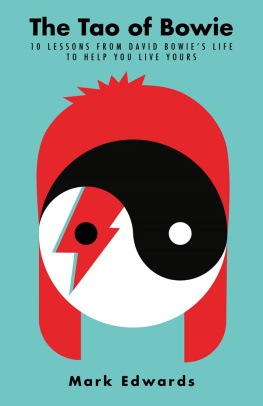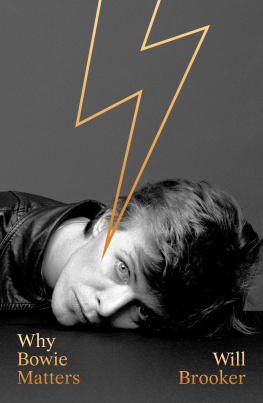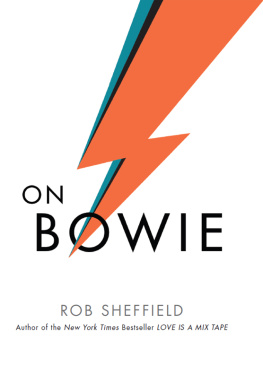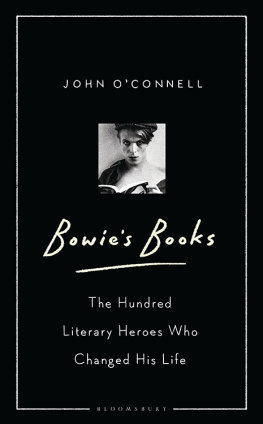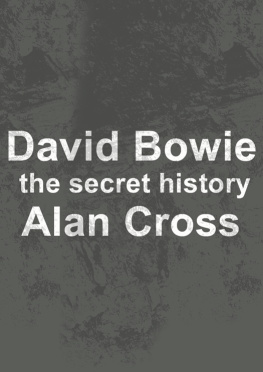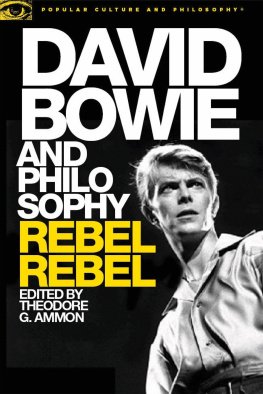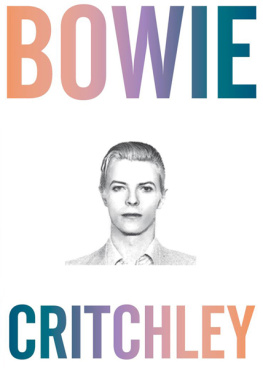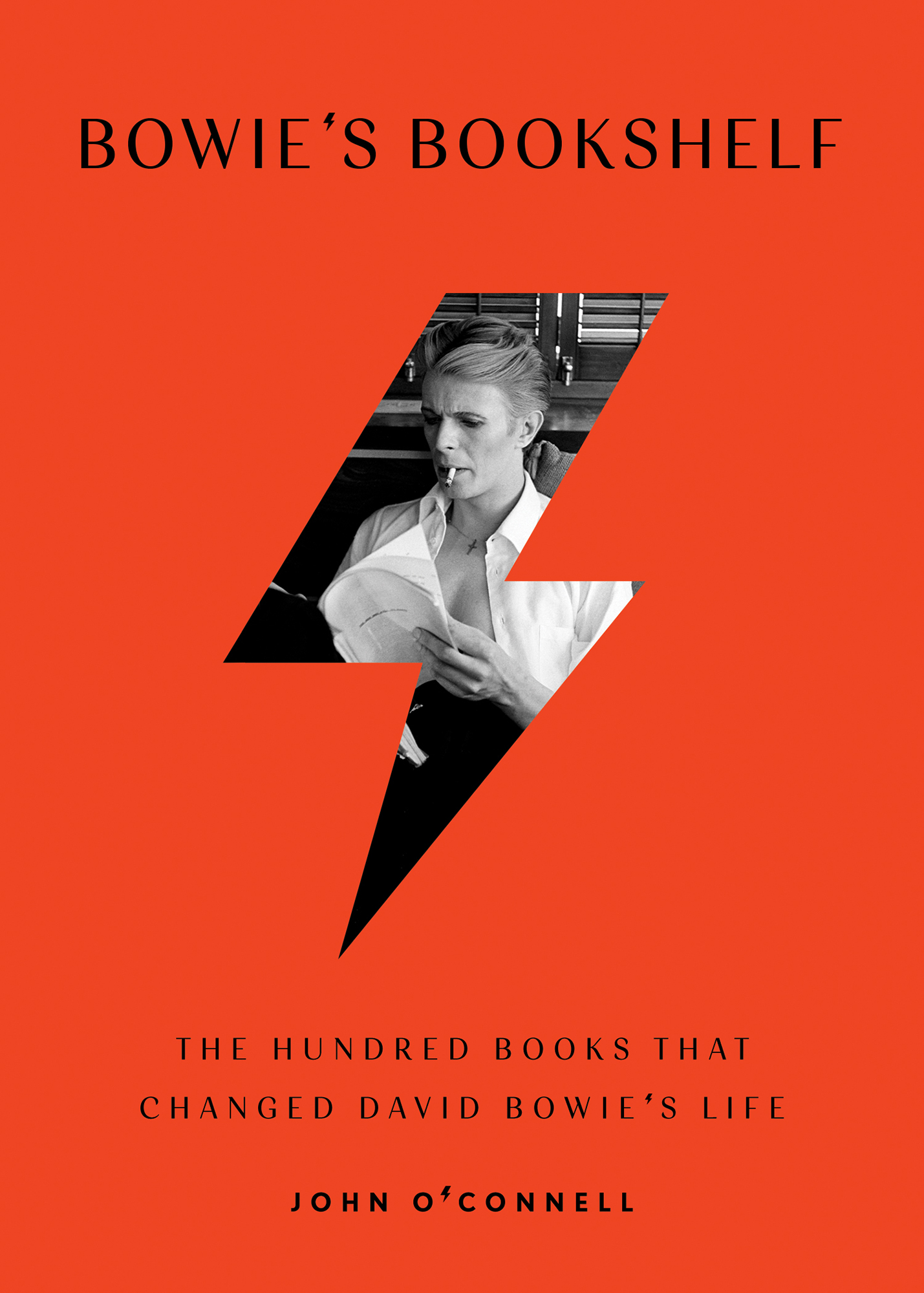Contents
Guide

Gallery Books
An Imprint of Simon & Schuster, Inc.
1230 Avenue of the Americas
New York, NY 10020
www.SimonandSchuster.com
Text copyright 2019 by John OConnell
Illustrations copyright 2019 by Luis Paadn
Originally published in Spain in 2019 by Blackie Books, Barcelona as El Club de Lectura de David Bowie
Permissions arranged by Blackie Books, S.L.U.
All rights reserved, including the right to reproduce this book or portions thereof in any form whatsoever. For information address Gallery Books Subsidiary Rights Department, 1230 Avenue of the Americas, New York, NY 10020
First Gallery Books hardcover edition November 2019
GALLERY BOOKS and colophon are registered trademarks of Simon & Schuster, Inc.
For information about special discounts for bulk purchases, please contact Simon & Schuster Special Sales at 1-866-506-1949 or
The Simon & Schuster Speakers Bureau can bring authors to your live event. For more information or to book an event contact the Simon & Schuster Speakers Bureau at 1-866-248-3049 or visit our website at www.simonspeakers.com.
Interior design by Alexis Minieri
Cover design by John Vairo Jr.
Cover photograph by Steve Schapiro/Getty Images
Library of Congress Cataloging-in-Publication Data
Names: OConnell, John (Music journalist) author.
Title: Bowies bookshelf : the hundred books that changed David Bowies life / John OConnell.
Description: New York : Gallery Books, 2019.
Identifiers: LCCN 2019028517 (print) | LCCN 2019028518 (ebook) | ISBN 9781982112547 (hardback) | ISBN 9781982112554 (ebook)
Subjects: LCSH: Bowie, DavidBooks and reading.
Classification: LCC ML420.B754 O3 2019 (print) | LCC ML420.B754 (ebook) | DDC 782.42166092dc23
LC record available at https://lccn.loc.gov/2019028517
LC ebook record available at https://lccn.loc.gov/2019028518
ISBN 978-1-9821-1254-7
ISBN 978-1-9821-1255-4 (ebook)
For Cathy, Scarlett, and Molly
INTRODUCTION
I n July 1975, stick-thin and in the grip of a severe cocaine addiction, David Bowie arrived in New Mexico to shoot The Man Who Fell to Earth. He was twenty-eight and had been cast in the lead role of alien emissary Thomas Jerome Newton after the films director, Nicolas Roeg, saw him in a BBC documentary called Cracked Actor and was struck by his air of ethereal otherness.
On set Bowie surprised everyone by being diligent and engaged, happy to banter with the crew and work on his lines with costar Candy Clark. He had, rather ambitiously, promised not to use drugs for the duration of the shoot, so when he wasnt needed he would take himself off to his trailer and indulge in an altogether less harmful pastime: reading books.
Luckily, he had plenty to choose from. As a Sunday Times location report explained, Bowie hates aircraft so he mostly travels across the States by train, carrying his mobile bibliothque in special trunks which open out with all his books neatly displayed on shelves. In New Mexico the volumes dealt mainly with the occult, his current enthusiasm. This portable library stored fifteen hundred titlesenough to make Clarks later observation to a journalist that Bowie really read a lot while making The Man Who Fell to Earth seem like a bit of an understatement.
Fast-forward to March 2013: The Victoria & Albert Museums exhibition David Bowie Is has opened in London to rave reviews and record-breaking ticket sales. A career retrospective featuring some five hundred items from the singers personal archive, including costumes, paintings, handwritten lyrics, and video storyboards, it will traverse the world before bowing out at New Yorks Brooklyn Museum just over five years later. To coincide with the opening in Ontario, the shows first port of call after London, the V&A issued the list, on which this book is based, of the hundred books Bowie considered the most important and influentialnot, note, his favorite books as suchout of the thousands he had read during his life.
These books had actually been a feature of the original London show, where a selection of them was suspended from the ceiling. Still, the list quickly went viral amid a flurry of incredulous commentary, much of it reducible to: Wow, who knew David Bowie read so much? Which was odd because Bowie had advertised his bookishness for years, not just in interviews but, more obliquely, in his work and the range of masks he wore when he presented it to the public.
The mobile-library story shows how Bowies reading had calcified into a compulsion by the time he achieved his goal of being world-famous. He went about it the way he went about everything, with a kind of manic fervor. As a casual habit, however, it would have started in his bedroom at 4 Plaistow Grove, the small terraced house in the London suburb of Bromley where he spent his formative years of childhood and adolescence.
Books were cool and sexy back then; even cooler and sexier than they are now. (Imagine!) Allen Lane didnt invent the paperback when, in 1935, he launched Penguin Books, but he used his marketing and entrepreneurial genius to democratize reading, making the worlds best writing available for the price of a packet of cigarettes. Bowies postwar generation was the first to take this phenomenon for granted so that by 1966, when the Beatles Paperback Writer hit number one, the term stood somehow for the takeover of Britains creative industries by people from provincial or working-class backgrounds.
Bowie underperformed at school and left in 1963 with just one qualification to his namea basic O level in art. Given the wide range of interests he subsequently cultivated, this suggests not laziness or an inability to retain information so much as impatience with formal education. Like many autodidacts, Bowie realized early on that he enjoyed teaching himself much more than he enjoyed being taught. And he took huge pleasure in passing on what he had learned to others: when he loved a book, friends say, he would proselytize passionately on its behalf.
This may be why, in 1998, he started writing book reviews for the US bookstore chain Barnes & Noble. They saw that I did a lot of book reviews on the site [his early website BowieNet], and they figured that it might not be a bad thing if they got me to do some for them as well, he told Time Out. I gave them five categories Id be interested in reviewing, from art to fiction to music. The first one Ive done is Glam! by Barney Hoskyns. Whats it like? Excellent.
Bowies creative method was particular and, until his imitators caught up with him, unusual for a pop musician. It involved opening himself wide to every possible influence. Not just other music butand this is what marked him outanything in any medium that might serve his vision. The resulting song, look, video, or album cover inevitably pointed the way home to its sources, but via multiple, circuitous routes, those sources having been distilled in the alembic of Bowies charisma until they were sometimes barely recognizable. Bowie liked reading, so there was a natural role for books in this process.


